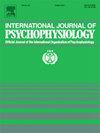How category frameworks shape the pre-activation of attentional templates: Evidence from high-resolution SSVEPs
IF 2.6
3区 心理学
Q3 NEUROSCIENCES
引用次数: 0
Abstract
During visual search, when targets are defined by specific categories, category-based attentional templates (CATs) enhance search efficiency by being pre-activated and modulated by their underlying category frameworks, thereby facilitating the detection of target objects. Previous studies employing the Rapid Serial Probe Presentation (RSPP) paradigm (20 Hz sampling rate) lacked the temporal resolution to continuously track CAT pre-activation dynamics. To address this, we used steady-state visual evoked potentials (SSVEPs) to capture real-time dynamics of CAT pre-activation, improving temporal resolution by 50 times (from 50 ms to 1 ms), enabling the detection of previously inaccessible transient neural processes. SSVEPs and multivariate pattern analysis (MVPA) revealed distinct pre-activation time courses for different CAT frameworks. Specifically, prototype-based CATs (involving perceptual similarity) were pre-activated earliest in posterior visual regions (1808 ms pre-target), followed by semantic-based CATs (involving experience and learning) in anterior temporal networks (1460 ms pre-target), and strategy-based CATs (involving learning) engaging prefrontal control systems last (359 ms pre-target). By uncovering the temporal hierarchy of CAT pre-activation across different cortical systems, our findings refine predictive coding theory, demonstrating how category frameworks shape the temporal dynamics of anticipatory attention and guide CAT pre-activation during visual search.
类别框架如何塑造注意模板的预激活:来自高分辨率ssvep的证据。
在视觉搜索过程中,当目标被定义为特定类别时,基于类别的注意模板通过其潜在类别框架的预激活和调制来提高搜索效率,从而促进目标对象的检测。以往采用快速串行探针呈现(RSPP)范式(20 Hz采样率)的研究缺乏持续跟踪CAT预激活动态的时间分辨率。为了解决这个问题,我们使用稳态视觉诱发电位(ssvep)来捕捉CAT预激活的实时动态,将时间分辨率提高了50倍(从50 ms提高到1 ms),从而能够检测到以前无法访问的瞬态神经过程。ssvep和多元模式分析(multivariate pattern analysis, MVPA)显示,不同CAT框架的预激活时间过程存在差异。具体而言,基于原型的cat(涉及感知相似性)在后视区域最早被预激活(1808 ms前目标),其次是基于语义的cat(涉及经验和学习)在后颞叶网络(1460 ms前目标),最后是基于策略的cat(涉及学习)参与前额叶控制系统(359 ms前目标)。通过揭示不同皮层系统中CAT预激活的时间层次,我们的发现完善了预测编码理论,展示了类别框架如何塑造预期注意的时间动态,并指导视觉搜索过程中的CAT预激活。
本文章由计算机程序翻译,如有差异,请以英文原文为准。
求助全文
约1分钟内获得全文
求助全文
来源期刊
CiteScore
5.40
自引率
10.00%
发文量
177
审稿时长
3-8 weeks
期刊介绍:
The International Journal of Psychophysiology is the official journal of the International Organization of Psychophysiology, and provides a respected forum for the publication of high quality original contributions on all aspects of psychophysiology. The journal is interdisciplinary and aims to integrate the neurosciences and behavioral sciences. Empirical, theoretical, and review articles are encouraged in the following areas:
• Cerebral psychophysiology: including functional brain mapping and neuroimaging with Event-Related Potentials (ERPs), Positron Emission Tomography (PET), Functional Magnetic Resonance Imaging (fMRI) and Electroencephalographic studies.
• Autonomic functions: including bilateral electrodermal activity, pupillometry and blood volume changes.
• Cardiovascular Psychophysiology:including studies of blood pressure, cardiac functioning and respiration.
• Somatic psychophysiology: including muscle activity, eye movements and eye blinks.

 求助内容:
求助内容: 应助结果提醒方式:
应助结果提醒方式:


